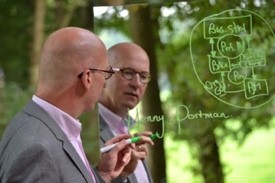Sensemaking in the Agile Forest
SERIES ARTICLE
By Henny Portman
The Netherlands
Introduction
In traditional project management, clients often complain that the project does not deliver on the agreed end date. In other words, they find that predictability leaves something to be desired! How do you ensure predictability as an agile team?
Hours or story points
You probably know this: when you ask two people how many hours it takes to create a user story, you get two different answers. What helps here is to work with a unit of measurement for the size of a user story, for example a storypoint. Storypoints represent the size of a user story, independent of the person who will realize the user story.
Planning poker
Planning poker is a technique in which the team assigns story points to a user story. As a frame of reference, the team usually uses a user story the size of one story point. All developers of the agile team give their estimate of the number of points of the current user story compared to the reference user story. Agile teams often use a modified Fibonacci sequence for this (1, 2, 3, 5, 8, 20, 40, 100). In practice, 1, 2, 3, 5 and 8 are sufficient values.

If it is larger than 8, it is recommended to split the user story into smaller user stories. This is also called ‘slicing’ or cutting into slices. After everyone has made their choice, everyone puts their estimate on the table. This is done ‘blind’, i.e. with the value facing the table top. Hence the name planning poker: the others are not allowed to see your chosen card yet. The team members with the highest and the lowest value may explain their choice, after which the whole team makes another estimate. This is usually sufficient to reach a joint decision on the number of points.
Data
Agile teams collect or should collect a lot of data. The estimation of the number of story points per user story is a source of data. The estimation of how many story points the team can realize in a sprint is also important data. This is called the velocity of the team. The average of stories a team delivers is another sort of data.
Novice team velocity
A starting team has no idea how many story points can be achieved and therefore cannot be as predictable as an established agile team. And that is not a bad thing. It has to learn and grow in maturity. Suppose the team starts with a velocity of 40 story points. At the end of the sprint, 6 user stories are accepted and delivered. These user stories represent a total of 20 story points.
In the next sprint they start with a velocity of 20. Halfway the team has already delivered 15 and they add a few more user stories. In the end, 24 story points are realized. After a number of sprints, it is clear what the velocity of the agile team is and the predictability of the team is greatly improved.
More…
To read entire article, click here
Editor’s note: This is the 10th article in a series by Henny Portman, one of the world’s leading authorities on “agile”. Based in The Netherlands, Henny coined the term “agile forest” in 2019 to describe the many agile frameworks that have emerged over the last 20 years. This series is intended to help readers better understand the agile concept, navigate through the ‘underbrush’ and more successfully apply whichever framework is selected for their projects.
How to cite this article: Portman, H. (2022). Being predictable as an agile team; Sensemaking in the Agile Forest series, PM World Journal, Vol. XI, Issue XI, November. Available online at https://pmworldlibrary.net/wp-content/uploads/2022/10/pmwj123-Nov2022-Portman-Being-predictable-as-an-agile-team-.pdf
About the Author

Henny Portman
The Netherlands
![]()
Henny Portman, owner of Portman PM[O] Consultancy and was partner of HWP Consulting, has 40 years of experience in the project management domain. He was the project management office (PMO) thought leader within NN Group and responsible for the introduction and application of the PMO methodologies (portfolio, program, and project management) across Europe and Asia. He trains, coaches, and directs (senior) programme, project and portfolio managers and project sponsors at all levels, and has built several professional (PM(O)) communities.
Henny Portman is accredited in a variety of qualifications, including P3O, PRINCE2, MSP, MoP, PRINCE2 Agile, AgilePM, AgilePgM and AgileSHIFT trainer and an SPC4 SAFe consultant and trainer. He is a P3M3 trainer and assessor and PMO Value Ring Certified Consultant (PMO Global Alliance). On behalf of IPMA, he assesses mega and large projects for the IPMA Project Excellence Award. In addition to this, he is an international speaker, author of many articles and books in the PM(O) field, and an active blogger. More at hennyportman.wordpress.com
Henny can be contacted at henny.portman@gmail.com
To view other works by Henny Portman, visit his author showcase in the PM World Library at https://pmworldlibrary.net/authors/henny-portman/









